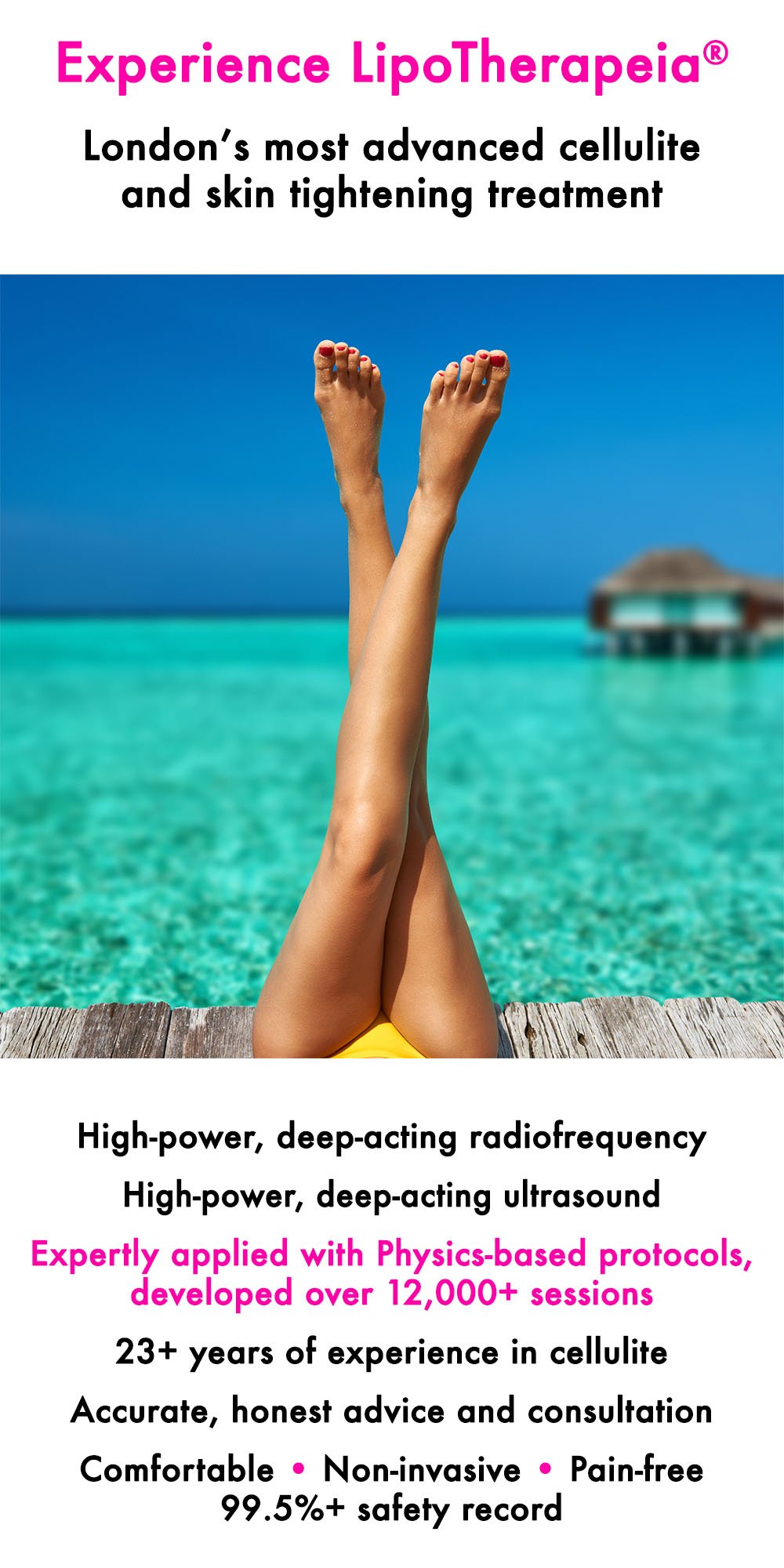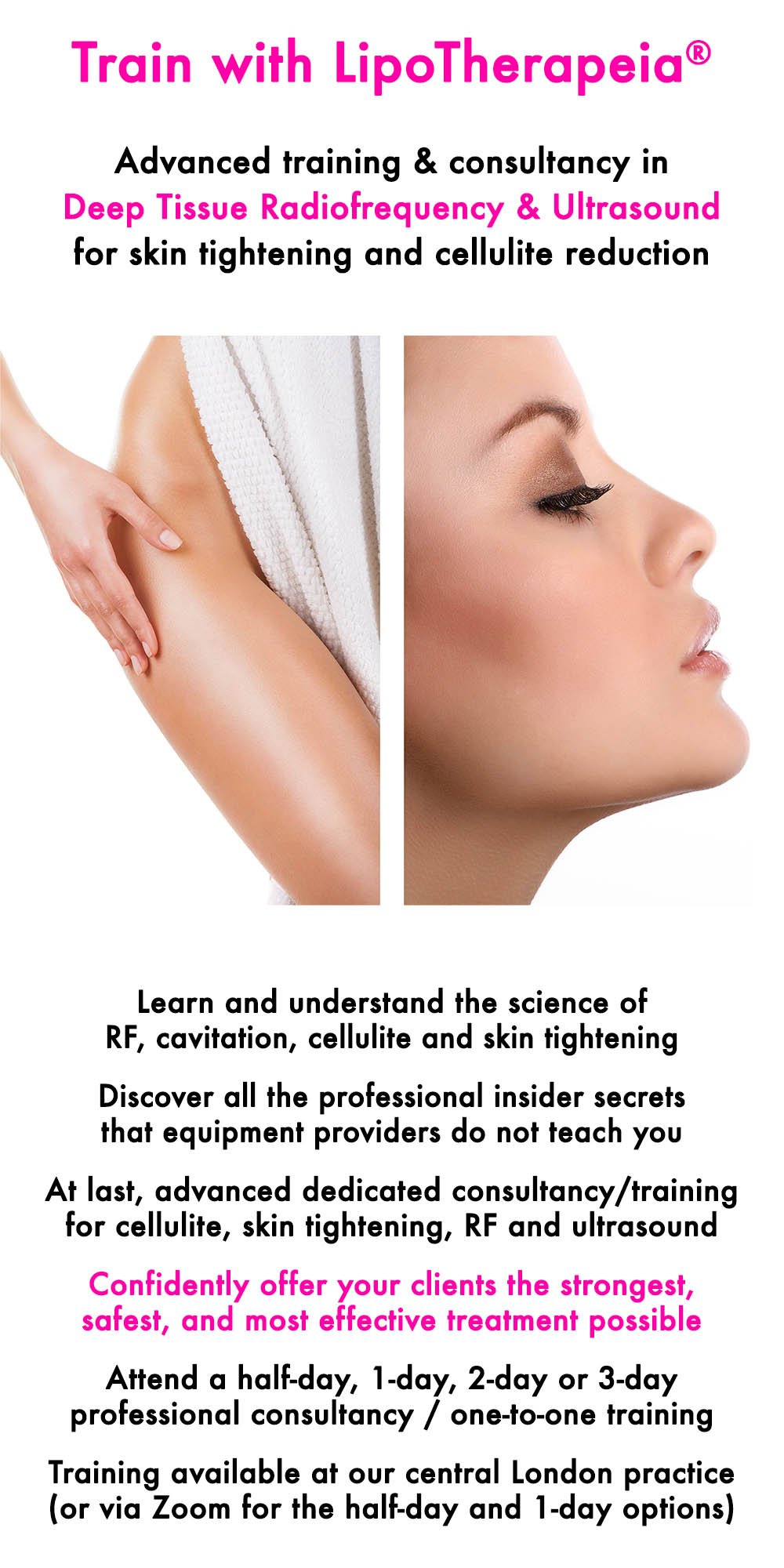The myth of “fascia blasting” for cellulite reduction
Our Beachy Legs articles are a nice way to share our experience and knowledge in cellulite and skin tightening, from our London clinic with everyone in the world. Check all our articles here. And if you do live in London, you can book an expert treatment here.
“Cellulite is just a fascia issue: blast it with a crude massage tool and your cellulite will be gone”
Fascia: the facts
“Cellulite is just fascia”: this statement and whole theory shows ignorance at multiple levels
One thing is certain: cellulite is not fascia
Beating up your poor fascia will not reduce your cellulite - but it can make your cellulite worse
Beating up your fascia will not firm up your skin either
Blasting your fascia with a tool is not necessary to boost circulation - the hands do a much better and more targeted job
Cellulite fibrosis and fascia poking
So how do you loosen up the retinaculae?
Instead of breaking down the shortened retinaculae, why not break down fat?
Check our professional consultancy in radiofrequency, ultrasound cavitation, cellulite and skin tightening
“Cellulite is just a fascia issue: blast it with a crude massage tool and your cellulite will be gone”
If you have researched cellulite you must have bumped on this. Someone one day discovered the existence of fascia and dreamed that “fascia is the cause of cellulite”.
And what do you do to fascia? But of course you just poke it, what else? Poke it as hard as you can with a crude fascia blasting tool, and your cellulite will go forever, right?
Now, that’s the definition of simple mind thinking.
Let’s look at the facts.
Fascia: the facts
Fascia is a widely encompassing term that refers to collagen-rich connective tissue found at different tissue depths, starting from just below the skin all the way into the muscles.
Fascia, as the name suggests (fascia it means frame) gives shape to our otherwise soft, “blobby” tissues.
In relation to skin, subcutaneous tissue and cellulite:
Your skin itself is fascia. Obviously you do not want to break down that fascia. Unfortunately, fascia blasting works on the skin (which is totally the wrong tissue) and can weaken it. No good.
Multiple parallel connective tissue sheaths under your skin, from a millimetre deep to centimetres deep are fascia (superficial fascia, intermediate fascia, deep fascia). These keep your tissues firm and you definitely do not want to break down them. Unfortunately fascia blasting works on those tissues (i.e. totally the wrong tissues) and can indeed break them down and weaken them. No good.
And skin ligaments that connect those parallel connective tissue sheaths are also fascia (retinaculae, septae). These are the fascia tissues implicated in the cellulite appearance. You do not want to break them down, just to loosen them. Luckily, fascia blasting tools do not break retinaculae down, neither they loosen them though. Pointless.
Individual fat cells are surrounded by fascia (periadipose connective tissue). Not affected by fascia blasters.
Multiple fat cells are surrounded by fascia. Not affected by fascia blasters.
Plus:
Ligaments are fascia
Tendons are fascia
Each muscle fibre is surrounded by fascia (endomysium)
Each bundle of muscle fibres is surrounded by fascia (perimysium)
Each muscle is surrounded by fascia (epimysium)
Entire muscle groups can be surrounded by fascia
Each organ is surrounded by fascia. Fat clusters are also surrounded by fascia
The above are irrelevant to fascia blasting for cellulite but are mentioned to make a point that fascia is so much more than “a cellulite thing” that needs to be broken down by punishing it and beating it up.
“Cellulite is just fascia”: this statement and whole theory shows ignorance at multiple levels
You can understand now how shallow the statement “cellulite is fascia” sounds. It means nothing. Someone discovered a new word and made a slogan out of it that means absolutely nothing.
It suits some people (who BTW do not even know what fascia or what cellulite is) but cellulite is much more than “fascia”: it is fat accumulation, water retention and skin laxity.
And yes, it is also fibrosis. Fibrosis (connective tissue hardening) of just one of the many aspects of fascia mentioned above: the skin retinaculae (more on that later).
Simplistic aphorisms such as “cellulite is fascia” do not help anyone, except those who want to sell badly designed “fascia” blasting massage tools.
Those fascia tools are ill-conceived and in fact they mainly affect:
Skin and the three subcutaneous fasciae (superficial, intermediate and deep)
The subcutaneous adipose tissue, which is below the hypodermis (cellulite layer)
So they totally miss the point.
A good cellulite-specific massage by hand will do a much better job, exactly where it is needed (at the hypodermis) and without tissue damage of the three subcutaneous fasciae or the skin.
One thing is certain: cellulite is not fascia
Furthermore, as mentioned above, cellulite is not just about collagen tissue, such as “fascia” or “septa”. It is a multi-faceted problem with fat being the number one issue.
The key component of cellulite, the elephant in the room, is hypodermal adipose tissue accumulation or, in plaint terms, skin FAT (cellulite is not even subcutaneous tissue, where “fascia blasting” tools act).
Beating up your poor fascia will not achieve anything - but it can make your cellulite worse
No fascia poking or fascia blasting will ever reduce hypodermal fat accumulation to a decent degree.
Yes, if you beat the cr*p out of your hypodermal and subcutaneous adipose tissues and their fasciae, that will lead to some fat tissue necrosis on both tissues, from all the damage that you will incur.
But that will not happen without damaging quite a lot of other useful tissues next to it, including the superficial, intermediate and deep fasciae themselves.
And believe me, you do not want to damage those fasciae, as you will simply end up with saggy, bumpy skin, which is much worse than cellulite.
Take it from someone who has done PROPER, well-thought out cellulite massage for years - before good, safe radiofrequency/cavitation machines emerged, which made cellulite almost massage obsolete.
(The best way to safely and effectively reduce hypodermal fat is a combination of deep-acting, high-power radiofrequency and high-power ultrasound cavitation - nothing else comes close.)
Beating up your fascia will not firm up your skin either
Which takes us to the next point: cellulite is also about weak connective tissue, i.e. loose skin and loose superficial and intermediate fascia.
Believe me, you do not want to further loosen up an already weak and loosened superficial and intermediate fascia. By poking with all your might into your skin and fat this is what you will achieve: to damage an already weak connective tissue.
The only proven thing to safely and effectively tighten the skin is deep-acting, high-power radiofrequency - and in some cases high-power ultrasound cavitation. Nothing else comes close.
The second best thing, a distant second, is vigorous, but never excessive, hand massage: skin kneading, skin rolling, long deep strokes. This in fact, will act at the right level, i.e. at the hypodermis, not the subcutaneous tissue where fascia tools act.
The only problem with cellulite massage for skin firming is that it is very slow acting: it takes months to give results and it is still not nearly as effective as deep tissue RF. So it is better suited for prevention.
Take it from someone who has done it for more than a decade, before good, safe radiofrequency machines became available.
Blasting your fascia with a tool is not necessary to boost circulation - the hands do a much better and more targeted job
The third component of cellulite is water retention. Sure, a good vigorous massage will reduce water retention and boost circulation. But you do not need to poke with all your might with a “blaster” for that to happen.
Some vigorous - but never excessive - long deep strokes, skin kneading and skin rolling with very little oil and your lovely hands (or those of a masseur) is all that is needed to boost circulation.
As mentioned above, those cellulite massage movements act at the right level: the hypodermis, not the subcutaneous tissue where fascia tools act.
Furthermore, a good, deep tissue, high-power radiofrequency treatment and/or high-power ultrasound cavitation treatment will boost circulation more than a hand massage - and definitely much more than poking with a fascia blaster.
Cellulite fibrosis and fascia poking
Now, as mentioned above, there is indeed one component of cellulite, out of the four, where partially loosening a very specific type of fascia makes sense.
I am talking about the skin retinaculae, the vertically oriented connective tissue fibres (skin ligaments, septa or “collagen bands” as some people call them).
These:
Connect dermis above them with the superficial fascia below them
And some more retinaculae also connect the superficial fascia above them with the intermediate fascia below them
The fibrotic, contracted and sometimes super-sized retinaculae are what keep the skin down, when fat globules push up. The shortened retinaculae, in combination with the outward pushing fat globules, create the mattress cellulite appearance.
Now blasting the fascia with all your might with a crude implement will NOT affect the retinaculae - not at all.
It may partially damage some fat globules (and lots of other healthy and necessary tissue around them) but most importantly it will damage the very well needed superficial fascia, intermediate fascia and even deep fascia, which keep your skin nice and firm.
Take it from someone who has done cellulite massage for years and who knows which massage movement acts on which exact tissue.
The rest of the force, the one that does not loosen up the horizontal fasciae layers, will be applied on the subcutaneous tissue below.
But defies the whole point: cellulite is a hypodermal tissue problem, not a subcutaneous tissue problem. Deep fat does not cause the cellulite appearance.
Plus fascia at the deep subcutaneous level is already loose - there is nothing to break there.
So how do you loosen up the retinaculae?
There is no amazing way to lengthen shortened retinaculae.
Some people try to completely cut out 20-30, out of hundreds of them, with subcision or cellfina surgery, and you end up with scar tissue at 20-30 incision points. Plus loose skin (the retinaculae are there to keep your skin in place, duh! So by undercutting them you get loose skin.
Some people try to melt them out with enzymes that break down collagen (collagenase injections, Qwo). However, those injections do not just melt away the retinaculae only but also other nice collagen tissue next to them. End result? You guessed it: loose skin, inflammation, tissue damage. BTW, the company that produced them recently goes bust. That says it all.
Some other people lift the skin and roll it with intense suction (palper-rouler with vacuum suction). But that also loosens up the dermis, the superficial fascia and the intermediate fascia. End result, loose skin. Plus thread veins from all the suction.
To be honest, I really do not understand all the obsession and the focus on the retinaculae / fascia.
How about reducing fat and skin looseness (weak connective tissue), which in combination caused all the problems in the first place?
Fat accumulation and skin laxity, brought on by years of poor diet, inactivity, smoking, drinking and exposure to estrogen (menstrual cycles, pregnancies, contraceptives) is what kick-starts and perpetuates the whole cellulite process.
Instead of breaking down the shortened retinaculae, why not break down fat?
Thankfully, some people actually do the opposite.
Instead of trying to break down some of the retinaculae in order to allow the fat globules to expand upwards, they try to remodel and tighten up all the retinaculae and the three fasciae - as well as reducing the fat globules in size - with deep-acting, high-power radiofrequency and high-power ultrasound cavitation.
This achieves two objectives at the same time: cellulite reduction AND skin tightening.
Some anti-cellulite cream active ingredients also help in all these processes. For example:
Asiatic acid, asiaticoside, madecassic acid, madecassoside (all from gotu kola), remodel and firm
EGCG (from green tea), remodels and firms
Curcumin (from turmeric), remodels and firms;
Forskolin and caffeine releases fat
Plus all these actives help with microcirculation at skin level.
The combination of proper ultrasound, proper radiofrequency and a proper cellulite cream can create firmer, less fibrotic skin and with less fat in it, i.e. win-win. Of course, all this has to be added to healthy nutrition and exercise - the basis of for cellulite prevention and reduction.
Who would have thought that reducing fat and tightening up skin and fascia makes more sense than breaking down the fascia, right?
Of course, this approach is not a miracle but after more than two decades in the industry, this is the only thing that I know to actually be both safe and effective - and I have researched literally everything.
Check our professional consultancy in radiofrequency, ultrasound cavitation, cellulite and skin tightening
If you are a therapist or clinic owner and are interested in our professional consultancy/teaching, via Zoom or at our London practice, please contact us here.





